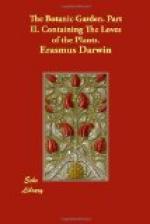155 So now DELANY forms her mimic bowers,
Her
paper foliage, and her silken flowers;
[So now Delany. l. 155. Mrs. Delany has finished nine hundred and seventy accurate and elegant representations of different vegetables with the parts of their flowers, fructification, &c. according with the classification of Linneus, in what she terms paper-mosaic. She began this work at the age of 74, when her sight would no longer serve her to paint, in which she much excelled; between her age of 74 and 82, at which time her eyes quite failed her, she executed the curious Hortus ficcus above-mentioned, which I suppose contains a greater number of plants than were ever before drawn from the life by any one person. Her method consisted in placing the leaves of each plant with the petals, and all the other parts of the flowers, on coloured paper, and cutting them with scissars accurately to the natural size and form, and then parting them on a dark ground; the effect of which is wonderful, and their accuracy less liable to fallacy than drawings. She is at this time (1788) in her 89th year, with all the powers of a fine understanding still unimpaired. I am informed another very ingenious lady, Mrs. North, is constructing a similar Hortus ficcus, or Paper-garden; which she executes on a ground of vellum with such elegant taste and scientific accuracy, that it cannot fail to become a work of inestimable value.]
Her
virgin train the tender scissars ply,
Vein
the green leaf, the purple petal dye:
Round
wiry stems the flaxen tendril bends,
160 Moss creeps below, and waxen fruit impends.
Cold
Winter views amid his realms of snow
DELANY’S
vegetable statues blow;
Smooths
his stern brow, delays his hoary wing,
And
eyes with wonder all the blooms of spring.
165 The gentle LAPSANA, NYMPHAEA fair,
And
bright CALENDULA with golden hair,
[Lapsana, Nymphaea alba, Calendula. l. 165. And many other flowers close and open their petals at certain hours of the day; and thus constitute what Linneus calls the Horologe, or Watch of Flora. He enumerates 46 flowers, which possess this kind of sensibility. I shall mention a few of them with their respective hours of rising and setting, as Linneus terms them. He divides them first into meteoric flowers, which less accurately observe the hour of unfolding, but are expanded sooner or later, according to the cloudiness, moisture, or pressure of the atmosphere. 2d. Tropical flowers open in the morning and close before evening every day; but the hour of the expanding becomes earlier or later, at the length of the day increases or decreases. 3dly. AEquinoctial flowers, which open at a certain and exact hour of the day, and for the most part close at another determinate hour.




